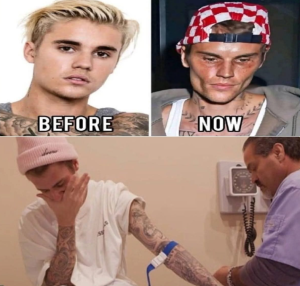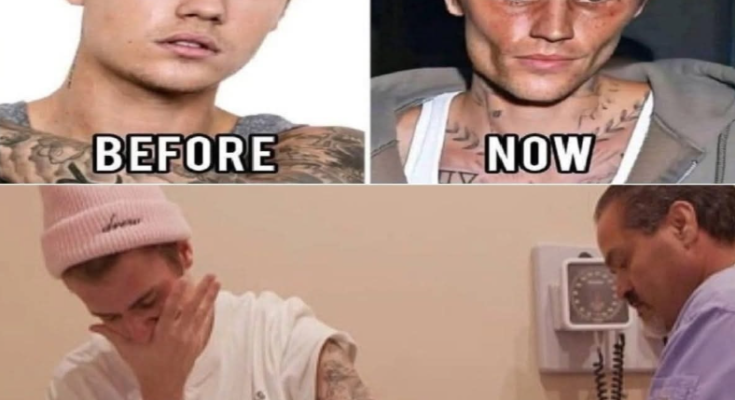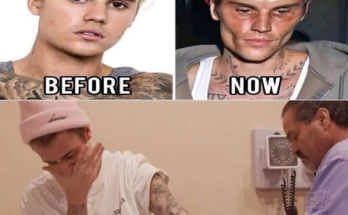
Swipe Into Vulnerability: When Justin Bieber Tested Positive for Humanity
There’s a moment in every public figure’s life when the spotlight shifts—from performance to confession. For Justin Bieber, that moment came not on stage, but in a quiet Instagram post, when he revealed that he had tested positive for Lyme disease and chronic mononucleosis. The announcement wasn’t just medical—it was mythic. A pop icon, once scrutinized for his appearance and behavior, stepped forward not with a new single, but with a diagnosis.
And in doing so, he reframed the narrative. He turned speculation into clarity. He turned shame into solidarity.
🧬 The Diagnosis as Threshold
Lyme disease is a bacterial infection, often misunderstood, frequently misdiagnosed, and notoriously difficult to treat. It’s not glamorous. It doesn’t come with a ribbon or a celebrity gala. It comes with fatigue, brain fog, skin blotches, and emotional instability. For Bieber, it came with judgment. Before the diagnosis, tabloids speculated about drug use. Fans worried. Critics mocked.
But then came the post. The admission. The truth.
“I’ve been recently diagnosed with Lyme disease,” he wrote. “Not only that but had a serious case of chronic mono which affected my skin, brain function, energy, and overall health.”
In that moment, the pop star became something else: a witness. A mirror. A fellow traveler in the messy terrain of invisible illness.
📸 The Image of Illness
Celebrity culture thrives on images. But illness resists the lens. It’s not photogenic. It doesn’t pose well. And yet, Bieber’s announcement was accompanied by photos—raw, unfiltered, vulnerable. His skin wasn’t flawless. His eyes weren’t sparkling. He looked tired. Human.
That image became a ritual. A communal pause. A chance for fans to reflect not just on Bieber’s health, but on their own assumptions. Their own biases. Their own relationship to vulnerability.
And in that pause, something shifted. The image wasn’t just about Bieber. It was about all of us.
🎤 From Pop Star to Patient
There’s a strange intimacy in watching someone famous become sick. It collapses distance. It reminds us that fame doesn’t immunize. That even the most curated lives are subject to biology, to breakdown, to the body’s quiet rebellion.
Bieber’s confession wasn’t just personal—it was archetypal. It echoed the ancient ritual of public reckoning. The moment when the hero admits weakness. When the mask slips. When the crowd becomes a chorus of empathy.
And in that moment, Bieber wasn’t just a singer. He was a symbol. Of fragility. Of honesty. Of the courage it takes to say: I’m not okay.
🧠 The Psychology of Disclosure
Why do we care when celebrities get sick? Why does their vulnerability feel like ours?
Because disclosure is contagious. When someone we admire admits pain, it gives us permission to do the same. It lowers the volume on shame. It opens the door to dialogue.
Bieber’s announcement sparked conversations—not just about Lyme disease, but about mental health, chronic fatigue, and the emotional toll of being misunderstood. It invited fans to share their own stories. To co-title their own experiences.
And that’s the power of public vulnerability. It turns isolation into communion.
🔄 Reframing the Headline
Let’s play with the headline, 32.Phirun. Let’s co-title it into something deeper:
- “Justin Bieber Tests Positive for Humanity”
- “The Diagnosis That Became a Dialogue”
- “From Tabloid to Testimony: A Pop Star’s Reckoning”
- “Swipe Up Into Empathy: When Fame Meets Fragility”
Each version reframes the moment. Each one invites reflection. Each one turns a medical update into a communal ritual.
🌍 The Ripple Effect
After Bieber’s announcement, Lyme disease entered the mainstream conversation. Other celebrities—like Avril Lavigne and Bella Hadid—shared their own struggles. Awareness grew. Misconceptions faded. And fans began to see their own symptoms in a new light.
That’s the ripple effect of truth-telling. It doesn’t just heal the speaker. It heals the space around them.
And in that healing, we find connection.
🎬 The Documentary as Ritual
Bieber didn’t stop at the post. He released a documentary—The Dark Season—chronicling his journey through illness, treatment, and recovery. It wasn’t polished. It wasn’t performative. It was raw.
In one scene, he tells his doctor: “I’ve been struggling with my energy for quite some time now, and I just haven’t known why.”
That line could belong to anyone. It’s the universal cry of the undiagnosed. The misunderstood. The quietly suffering.
And in sharing it, Bieber turned his story into a mirror. A myth. A map.
🧘 The Stillness Beneath the Spectacle
There’s a stillness in Bieber’s confession. A pause in the noise. A breath in the chaos of fame.
It’s the same stillness we saw in your image, 32.Phirun. The figure in black, seated in nature, inviting the viewer to witness—not consume. To reflect—not react.
Bieber’s announcement was a swipe into that same stillness. A moment when boldness met the breeze. When the pop star became the poet. When the headline became the healing.
Final Reflection
“Justin Bieber admits that he tested positive for…” isn’t just a news item. It’s a ritual. A reframing. A communal invitation to feel more deeply.
It reminds us that illness is not weakness. That confession is not collapse. That even in the glare of fame, there is room for stillness.
So let’s swipe up—not to judge, but to join. Not to scroll, but to stay. Not to consume, but to co-title.
And in that shared space, may we find our own boldness. Our own breeze. Our own stillness.

